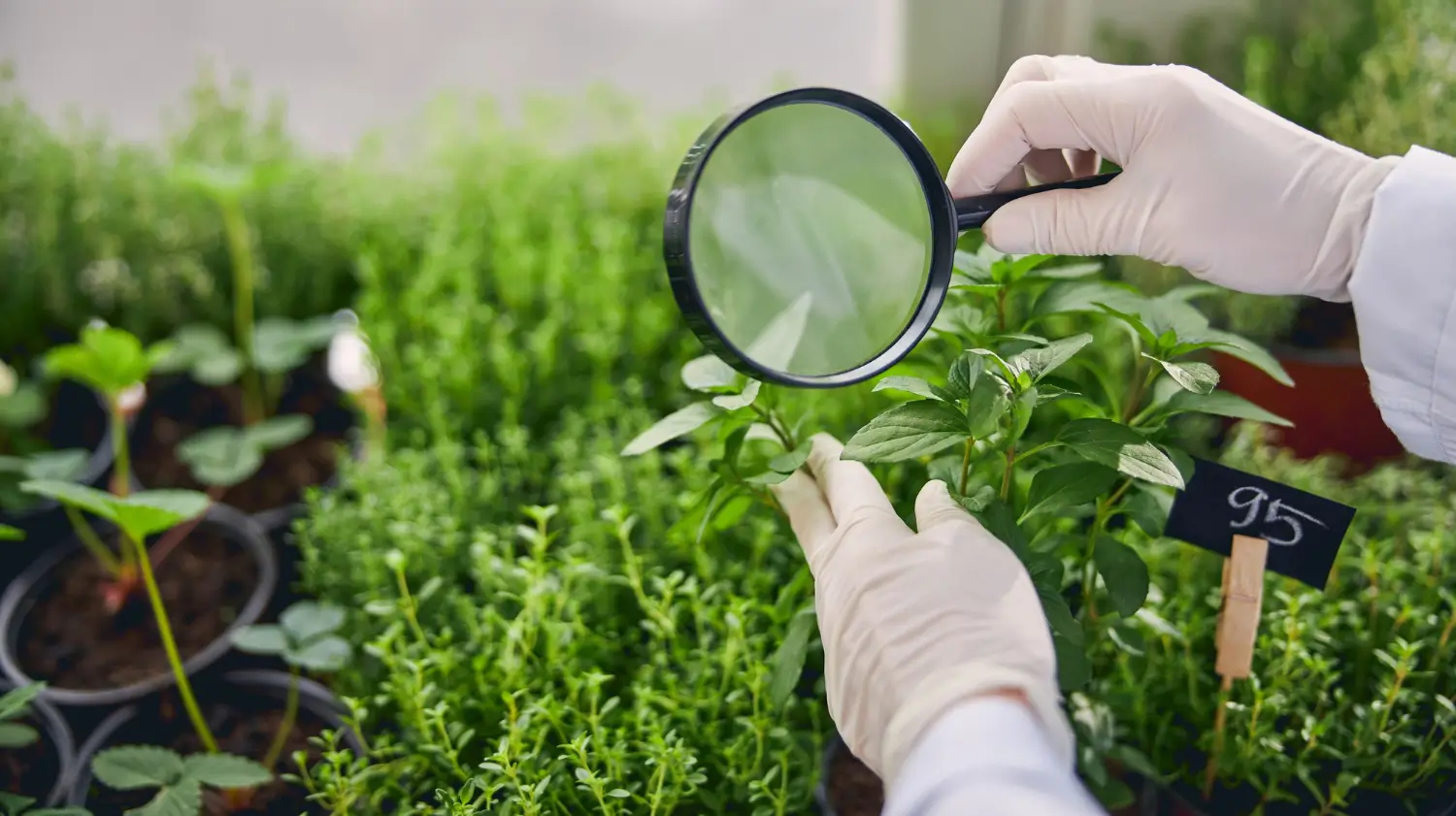
August 24, 2025

Greenhouses play a crucial role in modern agriculture by providing an optimal environment for plant growth, regardless of external weather conditions. With controlled temperature, humidity, and light, greenhouses allow growers to cultivate crops year-round, boosting productivity and ensuring a steady supply of food and ornamental plants. However, keeping plants healthy in a greenhouse can be challenging, especially when it comes to managing diseases.
In a greenhouse, plants are often placed close together, which can make it easier for diseases to spread quickly. A closed environment can also create conditions that are ideal for some diseases, such as high humidity and poor airflow. Additionally, diseases can enter the greenhouse through contaminated soil, infected seeds, unhealthy plants, and even human activity, making it hard to eliminate the risk of plant diseases completely.
Growcycle helps with disease management by offering tools and resources to support greenhouse growers in maintaining healthy crops. It also provides advice on best practices for disease prevention, such as proper sanitation, crop rotation, and the use of disease resistant plant varieties.
Plant diseases are conditions that affect plants and can harm or even kill them. Harmful organisms like fungi, bacteria, viruses, or nematodes usually cause them. These diseases can reduce plant growth, weaken plants, and lower the yield of crops in greenhouses. In severe cases, diseases can spread quickly, affecting many plants at once, which can result in significant losses for growers.
Plant diseases are especially concerning in a greenhouse because plants are grown in close quarters, making it easier for diseases to spread. With the right conditions, diseases can thrive, damaging the plants and affecting the overall productivity of the greenhouse.
Several environmental factors inside a greenhouse can contribute to the spread and development of plant diseases. These factors create conditions that are conducive to the growth of harmful pathogens, making it essential for greenhouse growers to manage them effectively.
Greenhouse plants are vulnerable to a variety of diseases that can negatively affect their growth and productivity. Early identification of these diseases is key to managing and preventing their spread. Here are some common plant diseases found in greenhouses, along with their symptoms and signs:
| Disease Type | Disease Name | Symptoms | Cause |
|---|---|---|---|
| Fungal Diseases | Powdery Mildew | White, powdery spots on leaves, stems, and flowers. Leaves may yellow and distort. | Fungal pathogen thriving in warm, dry conditions with high humidity. |
| Downy Mildew | Yellowing leaves with grayish or white mold on the underside. Stunted growth. | Fungal-like organism that thrives in humid, damp environments. | |
| Gray Mold (Botrytis) | Brown or gray fuzzy mold on dead or dying tissue. Causes rot in flowers, fruits, and leaves. | Fungi thrive in cool, moist conditions and spread in overcrowded areas. | |
| Bacterial Diseases | Bacterial Wilt | Leaves wilt and turn yellow from the base. Stem becomes mushy, plant may die. | Bacterial infection blocking the vascular system. |
| Leaf Spot | Dark spots on leaves with yellow halos, merging and killing leaves. | Bacteria infect through wounds or natural openings. | |
| Viral Diseases | Tobacco Mosaic Virus (TMV) | Mottled leaves with distorted growth. Yellowing, stunting, failure to bloom. | Virus spreads via infected tools, hands, or seeds. |
| Cucumber Mosaic Virus (CMV) | Yellowing, leaf mottling, curling, stunted growth, deformed flowers, reduced fruit. | Spread by aphids and insects carrying the virus. | |
| Nematode Diseases | Root-Knot Nematodes | Swelling or “knots” on roots, stunted growth, yellowing leaves, poor fruit production. | Microscopic worms feed on roots, hindering nutrient uptake. |
Diagnosing plant diseases early is important for controlling and preventing the spread of harmful pathogens. Growers can identify diseases and protect their crops by following a few simple steps.
Preventing diseases before they spread is the best way to maintain healthy plants in a greenhouse. Disease prevention can help to reduce the risk of major crop loss and ensure a more productive environment. Here are some preventive measures to follow:
Cleaning tools, containers, and surfaces regularly is one of the most effective ways to prevent disease spread. Bacteria, fungi, and viruses can be carried on equipment, so it is important to disinfect tools after each use. This also includes cleaning pots, trays, benches, and floors to remove any potential pathogens.
Choosing plant varieties that are resistant to common diseases can greatly reduce the risk of infection. Many crops now have varieties that are bred specifically to withstand diseases like mildew, bacterial wilt, or viruses, providing an extra layer of protection.
Control the greenhouse environment to make it less favorable for disease-causing organisms.
Biological control relies on the use of natural enemies of pests and pathogens to keep plant diseases in check. This method can be used to control both pests and diseases, reducing the need for chemical pesticides and promoting healthier plant growth.
Certain insects can help control pests that carry or cause plant diseases. Some examples include:
Microbial solutions use bacteria and fungi to combat plant diseases. These natural organisms can:
In greenhouses, predatory mites have been successfully used to control spider mites, which can cause significant damage to tomato plants by spreading diseases like powdery mildew.
Beneficial nematodes have also been used to reduce the population of root-feeding nematodes that damage strawberry plants, significantly improving crop yield and health.
Chemical pesticides, including fungicides, bactericides, and other treatments, can control diseases that other means cannot easily manage. These chemicals are effective at killing or inhibiting the growth of disease-causing organisms, but they should be used as part of an integrated pest and disease management strategy.
Overusing chemicals can lead to resistance, making them less effective over time. To avoid this, alternate between different classes of pesticides and use them sparingly. Always apply chemicals in a controlled manner to minimize runoff, which can harm surrounding ecosystems.
Avoid spraying on windy days and ensure proper disposal of chemical containers. When handling chemicals, always wear appropriate protective gear (gloves, masks, etc.) and follow safety guidelines to protect human health.
A well-planned greenhouse design is key to preventing and managing plant diseases. By optimizing the layout and structure of the greenhouse, growers can create an environment that reduces the risk of disease spread and improves plant health. Here are some important aspects of greenhouse design that contribute to disease prevention:
The design of a greenhouse directly influences the environment within it. A thoughtful layout can increase airflow, reduce humidity, and prevent overcrowding, all of which help control diseases. Proper planning also makes implementing other disease management practices, such as sanitation and pest control, easier.
Crowding plants too closely together can restrict airflow, increase humidity, and create an environment that encourages the growth of mold, fungi, and bacteria. Proper spacing between plants allows air to circulate freely, which helps to reduce moisture buildup and the risk of disease. In addition, adequate spacing ensures that plants receive enough light and nutrients for healthy growth, further boosting their resistance to diseases.
Irrigation systems should be designed to deliver water efficiently, ensuring that plants get the moisture they need without overwatering. Overwatering can create damp conditions that promote mold, mildew, and root rot.
Drip irrigation systems are a popular choice, as they deliver water directly to the base of the plants, minimizing excess moisture in the air and on plant leaves. This helps keep the greenhouse dry and reduces the risk of disease.
The materials used in constructing the greenhouse can impact the spread of diseases. High-quality, non-porous materials for surfaces and structures help reduce the chances of disease transmission.
For example, smooth surfaces on benches, trays, and floors are easier to clean and disinfect. Choosing materials resistant to mold and mildew can also help keep the greenhouse environment safer for plants.
Automated climate control systems like temperature and humidity regulators can help maintain optimal growing conditions. These systems ensure that temperature and humidity levels remain consistent, preventing conditions conducive to disease growth.
For example, automated fans or ventilation systems can regulate airflow, while heating systems can maintain a stable temperature. By automatically adjusting these factors, the greenhouse is kept at a level where diseases are less likely to thrive.
Regular plant inspections are the most effective way to catch disease problems early. By closely examining plants daily or weekly, growers can identify signs of disease, such as discoloration, spots, wilting, or unusual growth patterns.
Technology has revolutionized disease detection in greenhouses, offering innovative tools for early identification. Some examples include:
Routine testing and monitoring help growers stay ahead of potential problems, ensuring that they can address issues before they escalate. Some beneficial techniques include:
When early signs of disease are detected, prompt action is crucial to prevent further damage. Here’s how to respond effectively:
What are the main types of plant diseases in greenhouses?
The main types are fungal, bacterial, viral, and nematode diseases, each affecting plants in different ways.
How can high humidity in greenhouses contribute to plant diseases?
High humidity creates a perfect fungal and bacterial growth environment, leading to mold and plant infections.
What preventive measures can be taken to avoid plant diseases in greenhouses?
Sanitation, disease-resistant plants, environmental management, and crop rotation help prevent plant diseases.
Managing plant diseases in greenhouses is essential for healthy and productive crops. Important methods include controlling the environment, keeping the space clean, using disease-resistant plants, and applying biological or chemical treatments when needed.
Technology can also help detect problems early before they spread. Greenhouse growers can improve plant health, reduce losses, and keep a steady supply of high-quality crops by focusing on disease management. Explore Growcycle to find the best solutions to greenhouse diseases.
Disclaimer: This material is for informational purposes only and should not be relied on for legal, medical, financial, or any other form of professional advice.